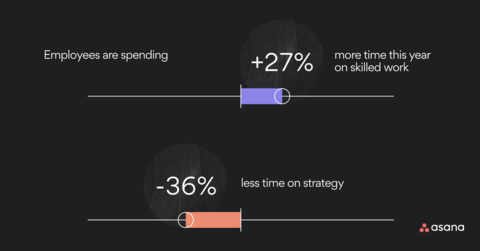Almost 1 in 4 workers experienced burnout 4 or more times in the past year
Employees waste 6 working weeks each year on a combination of duplicated work and unnecessary meetings
Asana, Inc. (NYSE: ASAN)(LTSE: ASAN), a leading work management platform for teams, today released its annual Anatomy of Work Index, an in-depth analysis into how people spend time at work. While hybrid and remote work trends have afforded greater flexibility for employees, the majority of their day — 58% — is still being lost to work coordination rather than the skilled, strategic jobs they’ve been hired to do.
This press release features multimedia. View the full release here: https://www.businesswire.com/news/home/20220405005399/en/

With greater ability to focus at home, individuals are dedicating 33% of their day to skilled work, a 27% increase year over year. However, time spent on strategy comprises less than 10% of their working day, a staggering 36% decrease from last year. (Photo: Business Wire)
More than two years of pandemic-era work has dramatically changed how employees spend their time. With greater ability to focus at home, individuals are dedicating 33% of their day to skilled work, a 27% increase year over year. However, time spent on strategy comprises less than 10% of their working day, a staggering 36% decrease from last year, reflecting the challenges organizations have in getting distributed teams on the same page to plan for the future.
With these upwards and downwards trends, it's no surprise that employees' own view of how and where they maximize their day has evolved. Workers ideally want a near equal split of time spent in the office (19 hours) and at home (20 hours) each week. More than ever, the office is being favored for collaborative-centric activities like onboarding, 1:1 meetings with their manager and strategy sessions, while home is the preferred location for their skilled job.
Conducted by Global Web Index (GWI) on behalf of Asana, the Anatomy of Work Index 2022 surveyed the behaviors and attitudes of 10,624 knowledge workers across Australia, France, Germany, Japan, Singapore, the U.K., and the U.S., to understand what’s working—and what's not—in the new era of organizational agility.
Moving Forward (and Backwards) Into the Future of Work
Today, the lines between work and life are blurrier than ever. Regardless of whether organizations choose an in-person, hybrid or fully remote model, a lack of clarity, coupled with increasing digital distractions, are continuing to fuel challenges for workers around the world.
While employees are missing fewer deadlines — 15% versus 26% last year — they're struggling to balance priorities and establish clear boundaries. For example, employees waste 6 working weeks each year on a combination of duplicated work and unnecessary meetings. With 37% saying that they don’t have a clear start or finish time to their working day — rising to 53% for Gen Z employees — there's a need to implement consistent guidelines and processes to better manage both remote and in-person collaboration.
Additional global findings include:
-
Managers spend the most time every day on work coordination (62%) followed by the C-Suite (60%)
- As an organization grows so does work about work. Employees at medium and large companies spend 59% of their day on it. That’s 5% more time than small businesses
- Too many meetings (24%) and uncertainty over what to prioritize (22%) are leading to missed deadlines
-
Overall, workers are using slightly fewer apps per day (9) than last year (10), but they still feel overwhelmed by them. Compared to one year ago:
- 42% are spending more time on email
- 40% are spending more time on video calls
- 52% are multitasking more during virtual meetings
- 56% feel they need to respond immediately to notifications
- Despite nearly half of employees (47%) finding it easier to concentrate at home, 41% feel more isolated when working remotely
Between grappling with work about work and navigating never-ending pings and notifications, burnout remains a persistent challenge for global employees. While overall levels of burnout have improved slightly — decreasing from 71% to 63% — the problem is pervasive among younger workers with 84% of Gen Z reporting burnout in the last year. And with almost 1 in 4 workers experiencing burnout 4 or more times, 42% experiencing burnout and imposter syndrome simultaneously and 40% believing it’s an inevitable part of success, organizations need to do more to set clear boundaries and prioritize employee well-being.
“The unprecedented disruption of the pandemic has fundamentally shifted the way we live, including re-thinking work and our relationship with it,” said Anne Raimondi, Chief Operating Officer, Asana. “As we transition into the new era of agile work, it’s crucial for organizations to connect their teams around clarity of purpose and a shared sense of accomplishment to ensure employees feel seen, heard and valued. In doing so, we can emerge from the burnout and bottlenecks of the past two years to chart a new path forward in the future of work.”
Despite the adaptations organizations have made since the onset of the pandemic, the survey findings illustrate the vast differences and opportunities to redefine work around the world:
- Australian workers are the most likely to say better mentoring and training could alleviate burnout and imposter syndrome — 45% are experiencing both at the same time
- Despite French employees spending the most time in the office (27 hours) they're also missing the most deadlines each week (25%)
- Germany is spending the least time on work about work (53%), though time spent on strategy has also halved to 7% (versus 14% last year)
- Japanese workers are spending the least time in unnecessary meetings compared to other markets (2 hours a week)
- Singapore is spending the most time on work about work (69%) — rising year over year while work about work has decreased globally
- U.K. workers spend the least amount of time in the office per week (18 hours) and miss the fewest deadlines
- Employees in the U.S. experienced burnout an average of 2.3 times in the past year — the highest globally
The New Era of the Agile Workplace
Today, organizations have a tremendous opportunity to reflect on the challenges of the past and the progress being made as they embrace the future of the agile workplace.
One in five workers say mental health resources and clarity on organizational goals would alleviate the impact of burnout and imposter syndrome. Additionally, employees say they could save 5.4 hours per week — equivalent to 6 working weeks (257 hours) a year — if processes were improved.
"In 2022 and beyond, leaders must constantly assess what their employee needs are and what sentiment on their team is like," said Dr. Sahar Yousef, Cognitive Neuroscientist, UC Berkeley. "The companies who will thrive in the new era of agility will be the ones who continue to evolve and, as a result, attract and retain better talent because they listen and adjust accordingly. Organizations that don’t will be left in the dust."
Asana’s Anatomy of Work Index 2022 and more information about the findings are available for download: https://asana.com/resources/anatomy-of-work
About Asana
Asana helps teams orchestrate their work, from small projects to strategic initiatives. Headquartered in San Francisco, CA, Asana has more than 119,000 paying customers and millions of free organizations across 190 countries. Global customers such as Amazon, Affirm, Japan Airlines, and Sky rely on Asana to manage everything from company objectives to digital transformation to product launches and marketing campaigns. For more information, visit www.asana.com.
Research Methodology
In October 2021 quantitative research was conducted by GWI on behalf of Asana, to understand how people spend time at work. Asana and Global Web Index co-designed the questionnaire and surveyed the behaviors and attitudes of 10,624 knowledge workers across Australia, France, Germany; Japan; Singapore; the U.K., and the U.S.
View source version on businesswire.com: https://www.businesswire.com/news/home/20220405005399/en/
Contacts
Alexandra Tadeu
press@asana.com






